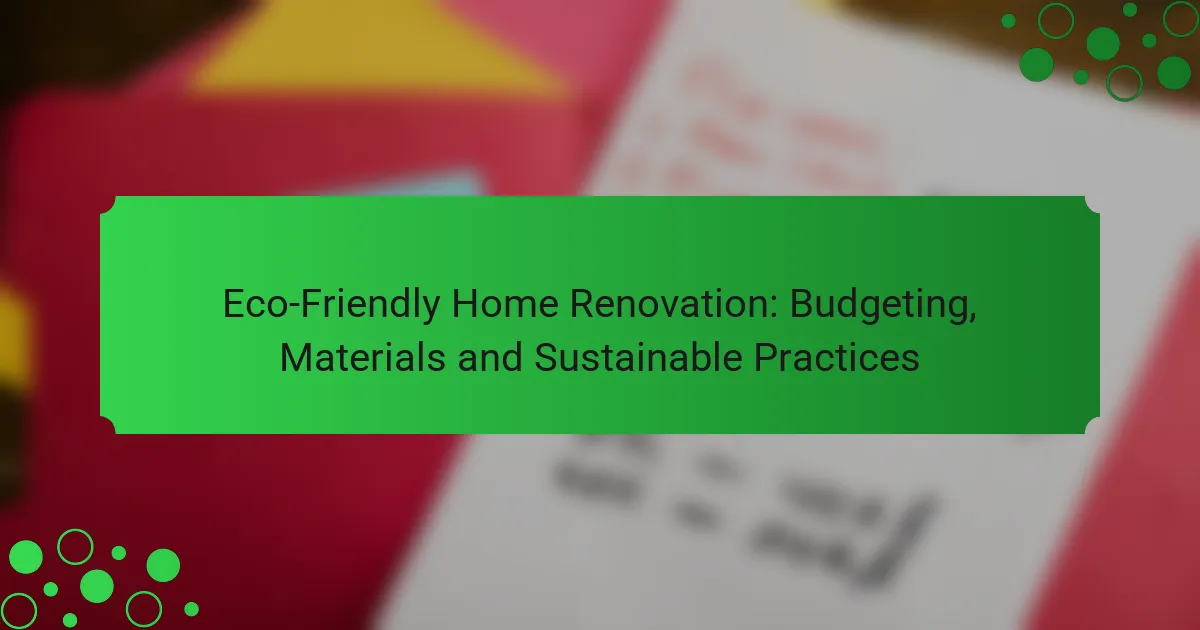Renovating your home with eco-friendly practices not only enhances its aesthetic appeal but also significantly reduces its environmental impact. By selecting sustainable materials and implementing energy-efficient solutions, homeowners can create a healthier living space while staying mindful of their budget. Understanding the costs associated with these choices is essential for making informed decisions that benefit both the planet and your finances.

What are the best eco-friendly materials for home renovation?
The best eco-friendly materials for home renovation include options that minimize environmental impact while providing durability and aesthetic appeal. These materials often come from sustainable sources, are recyclable, or have low emissions, making them ideal for creating a greener home.
Recycled steel
Recycled steel is a strong and durable material that significantly reduces the need for new steel production, which is energy-intensive. Using recycled steel can lower greenhouse gas emissions and conserve natural resources. It is commonly used in framing, roofing, and structural components.
When choosing recycled steel, look for products certified by organizations such as the Steel Recycling Institute, which ensures the material meets specific sustainability standards. This can also help you avoid potential pitfalls associated with lower-quality recycled options.
Sustainable wood
Sustainable wood comes from responsibly managed forests that adhere to strict environmental and social standards. Options like bamboo, reclaimed wood, and certified timber (e.g., FSC-certified) are excellent choices for flooring, cabinetry, and furniture.
When selecting sustainable wood, verify certifications and consider the wood’s lifecycle impact. Avoid tropical hardwoods that may contribute to deforestation and opt for local sources to reduce transportation emissions.
Low-VOC paints
Low-VOC (volatile organic compounds) paints are formulated to emit fewer harmful chemicals into the air, improving indoor air quality. These paints are available in a wide range of colors and finishes, making them suitable for various renovation projects.
When purchasing low-VOC paints, check labels for VOC content, aiming for products with less than 50 grams per liter. This not only benefits your health but also aligns with many local regulations promoting safer indoor environments.
Reclaimed bricks
Reclaimed bricks are salvaged from old buildings and can add character and history to your renovation. Using these bricks reduces waste and the demand for new materials, making them an eco-friendly choice for walls, patios, and pathways.
Ensure that reclaimed bricks are structurally sound and free from contaminants. You may need to clean or treat them before use, but the unique aesthetic they provide can enhance your home’s appeal.
Eco-friendly insulation
Eco-friendly insulation options, such as cellulose, sheep’s wool, or recycled denim, offer effective thermal performance while being less harmful to the environment. These materials help reduce energy consumption by maintaining comfortable indoor temperatures.
When selecting insulation, consider its R-value, which measures thermal resistance. Look for products that are certified for low environmental impact and ensure proper installation to maximize efficiency and avoid moisture issues.

How to budget for eco-friendly home renovations?
Budgeting for eco-friendly home renovations involves assessing the costs of sustainable materials, energy savings, and long-term investments. By prioritizing these aspects, homeowners can create a financial plan that supports environmentally responsible choices while staying within their budget.
Estimate costs for sustainable materials
When estimating costs for sustainable materials, consider options like reclaimed wood, bamboo, or recycled metal, which can vary widely in price. Generally, these materials may cost 10-30% more than conventional options, but their durability and reduced environmental impact can justify the investment.
It’s essential to research local suppliers and compare prices to find the best deals. Additionally, look for certifications such as FSC (Forest Stewardship Council) or Cradle to Cradle to ensure the materials meet sustainability standards.
Factor in energy savings
Energy-efficient renovations can lead to significant savings on utility bills, making them a crucial part of your budget. For example, upgrading to Energy Star-rated appliances or installing solar panels may require a higher upfront cost but can reduce energy expenses by 20-50% over time.
When budgeting, consider local incentives or rebates for energy-efficient upgrades, which can offset initial costs. Research your area’s regulations and available programs to maximize your savings.
Consider long-term investments
Long-term investments in eco-friendly renovations often yield financial and environmental benefits. Features like high-quality insulation, energy-efficient windows, and sustainable landscaping can increase your home’s value and reduce maintenance costs over the years.
Evaluate the payback period for each investment. For instance, while solar panels may take several years to pay off, their lifespan can exceed 25 years, making them a worthwhile consideration. Prioritize renovations that align with both your budget and your long-term sustainability goals.

What are effective sustainable practices in home renovation?
Effective sustainable practices in home renovation focus on reducing environmental impact while enhancing energy efficiency and resource conservation. These practices include using energy-efficient appliances, implementing water conservation techniques, and incorporating passive solar design principles.
Energy-efficient appliances
Energy-efficient appliances consume less electricity and water compared to standard models, leading to lower utility bills and reduced environmental impact. Look for appliances with the ENERGY STAR label, which indicates they meet strict efficiency guidelines set by the U.S. Environmental Protection Agency.
When renovating, prioritize replacing old appliances with newer, more efficient models. For example, an ENERGY STAR-rated refrigerator can use about 15% less energy than a non-rated model, translating to significant savings over time.
Water conservation techniques
Implementing water conservation techniques can significantly reduce water usage in your home. Simple changes such as installing low-flow faucets, showerheads, and toilets can cut water consumption by 20-60% without sacrificing performance.
Consider using rainwater harvesting systems to collect and reuse rainwater for irrigation or non-potable uses. In some regions, this practice can also qualify for local rebates or incentives, making it a financially attractive option.
Passive solar design
Passive solar design utilizes the sun’s energy for heating and cooling without mechanical systems. This approach involves strategic placement of windows, walls, and overhangs to maximize natural light and heat during winter while minimizing it during summer.
When renovating, consider adding large south-facing windows or thermal mass materials like concrete or stone that can absorb and store heat. These features can reduce reliance on heating and cooling systems, leading to lower energy costs and a more comfortable living environment.

What are the local regulations for eco-friendly renovations in California?
In California, local regulations for eco-friendly renovations focus on sustainability, energy efficiency, and environmental impact. Homeowners must comply with state and local building codes that promote the use of sustainable materials and energy-efficient practices.
Building codes for sustainable materials
California’s building codes encourage the use of sustainable materials through various standards, such as the California Green Building Standards Code (CALGreen). This code mandates that new constructions and major renovations incorporate eco-friendly materials that reduce environmental impact.
When selecting materials, consider options like recycled content, rapidly renewable resources, and non-toxic finishes. For example, using bamboo flooring or reclaimed wood can meet sustainability requirements while enhancing aesthetics.
Permits for energy-efficient upgrades
Energy-efficient upgrades often require specific permits to ensure compliance with local regulations. Homeowners should check with their city or county building department to determine which upgrades, such as solar panel installations or high-efficiency HVAC systems, necessitate a permit.
Common energy-efficient upgrades that typically require permits include insulation improvements, window replacements, and the installation of energy-efficient appliances. Always verify local guidelines to avoid fines or delays in your renovation project.

How to choose a contractor for eco-friendly renovations?
Choosing a contractor for eco-friendly renovations involves identifying professionals who prioritize sustainability and have relevant experience. Focus on their certifications, past projects, and customer feedback to ensure they align with your eco-friendly goals.
Look for green certifications
When selecting a contractor, prioritize those with recognized green certifications such as LEED (Leadership in Energy and Environmental Design) or Green Building Council memberships. These credentials indicate that the contractor is knowledgeable about sustainable practices and adheres to industry standards.
Additionally, check for local certifications that may apply, such as Energy Star or specific state-level green building programs. These can provide further assurance of the contractor’s commitment to eco-friendly renovations.
Check past sustainable projects
Review the contractor’s portfolio to assess their experience with sustainable renovations. Look for projects that showcase the use of eco-friendly materials, energy-efficient systems, and innovative design solutions that minimize environmental impact.
Ask for case studies or references from previous clients who undertook similar eco-friendly renovations. This will give you insight into the contractor’s ability to deliver quality results while adhering to sustainable practices.
Evaluate customer reviews
Customer reviews can provide valuable information about a contractor’s reliability and quality of work. Look for feedback specifically mentioning the contractor’s approach to sustainability and how well they executed eco-friendly renovations.
Utilize online platforms and local community boards to gather a range of opinions. Pay attention to any recurring themes in the reviews, such as communication, adherence to budget, and the overall satisfaction of clients with their sustainable renovations.

What are the benefits of eco-friendly home renovations?
Eco-friendly home renovations offer numerous advantages, including enhanced property value and reduced utility costs. These improvements not only contribute to environmental sustainability but also create a healthier living space.
Increased property value
Investing in eco-friendly renovations can significantly boost your property’s market value. Homes equipped with energy-efficient features, such as solar panels or high-quality insulation, are increasingly attractive to buyers who prioritize sustainability.
Consider focusing on renovations that align with local market trends. For instance, in urban areas, green roofs or energy-efficient windows may yield higher returns, while rural properties might benefit from sustainable landscaping or water conservation systems.
Lower utility bills
One of the most immediate benefits of eco-friendly renovations is the reduction in utility bills. Upgrading to energy-efficient appliances and installing proper insulation can lead to savings of 20-30% on monthly energy costs.
To maximize savings, consider implementing smart home technologies that monitor energy usage. Additionally, using renewable energy sources, such as solar or wind, can further decrease reliance on traditional utilities, providing long-term financial benefits.
